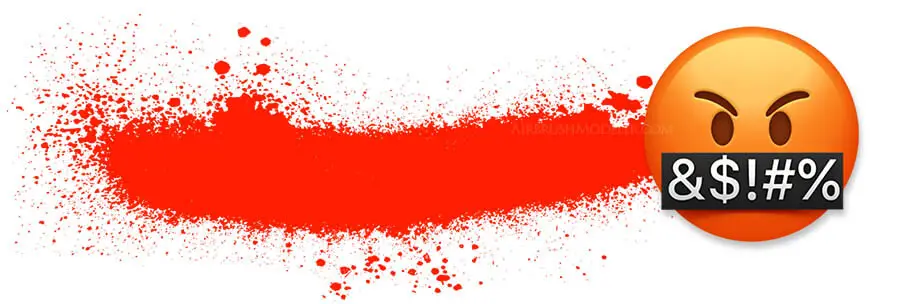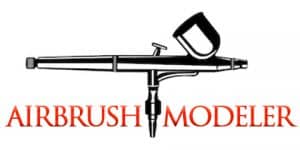What Causes Airbrush Paint Splatter

Airbrush paint splatter that is continuous is caused by over-thinned paint or excessive air pressure being delivered to your airbrush. However airbrush paint splatter that comes in random bursts can be caused by inconsistent pressurised airflow, or partial airbrush blockages brought on for a number of reasons.
It’s important to identify which type of splatter you’re experiencing so that you can properly remedy the problem (as will be shown in detail below) however to ensure the very best airbrush spray quality possible it’s usually best to cover off all bases for both types of airbrush paint splatter.
Additionally, there is also a difference between airbrush paint splatter and airbrush spatter and you should know exactly which is which so you can diagnose the fix your problem, otherwise you will have a very frustrating time trying to solve your issue.
I’ll do a comparison below so that you know how to exactly identify the problem you have and rectify it asap! 👊
The Difference Between Airbrush Paint “Splatter” And “Spatter”
The difference between airbrush splatter and airbrush spatter is the splatter sends a LOT of well-thinned paint to the surface of the job and “SPLATS”, and spatter sends paint to the surface without having properly atomised it into a fine mist.
What Is Airbrush Paint “Splatter”
Airbrush paint splatter happens when too much heavily thinned paint leaves the airbrush and “splats” onto surface.
This can happen in a continuous stream causing an almost instant paint run, spidering (where runs of paint spread out from the centre like spiders legs), or it can hit like water would on hard ground and essentially splash out from the centre.
What Is Airbrush Paint “Spatter”
Airbrush paint spatter, or airbrush spitting, is when the airbrush ‘spits’ droplets of paint onto the surface of your job that haven’t been quite properly atomised into a fine mist.
This spatter results in a speckled appearance to the paint on the surface which can be very minor or quite severe.
Generally it happens for the opposite reasons that airbrush paint ‘splatter’ happens, namely, the paint is not thinned enough and won’t atomise properly, or the air pressure is too low also ensuring that the paint doesn’t atomise in the airbrush properly.
👍 For more detailed information on airbrush spatter (or airbrush spitting) check out this in-depth article on what causes it and TEN way to fix it fast!
The Main Causes Of Airbrush Paint Splatter
The main causes of airbrush paint splatter are over thinned paint and excessive air pressure.
Learn about each in detail below and then we’ll look at the ways to eliminate paint splatter altogether.
Airbrush Paint Splatter Due To Over Thinned Paint
If your paint is too thin, while the airbrush will atomise it perfectly, it will hit the surface of your job but it won’t form a coherent and well-bonded film of paint, rather it will run very quickly.
If it is too thin it will actually ‘splat’ or ‘splash’ onto the surface and tiny droplets will bounce off the surface and around the centre point where it impacted just like water would if you poured it out of a cup and onto concrete.
Airbrush Paint Splatter Due To Excessive Air Pressure
If the air pressure is too high it can spray the atomised paint onto the surface with such force that ‘splats’ or ‘splashes’, again, in much the same way that water would if poured onto a hard surface like concrete.
With both methods, it can be a single splat if you trigger the paint to flow then release the trigger almost immediately, or it can be a continuous splattering if you keep the trigger open and try to paint a surface.
Regardless of how long you leave the trigger open for the remedy for fixing each type of airbrush paint splatter is the same…
How To Fix Airbrush Paint Splatter
Airbrush paint splatter can be fixed through adjusting the thinning ratio of your paint, lowering the air pressure delivered by your compressor, or a combination of both.
First let’s take a look at how to remedy the air pressure side of things before moving onto proper thinning of your paint…
Reducing Air Pressure To Fix Airbrush Paint Splatter
A reduction in air pressure is perhaps the quickest and easiest method of fixing airbrush paint splatter and often will fix the problem perfectly without any need to alter the thinning ratio of the paint.
Steps To Fixing Airbrush Paint Splatter (pressure adjustments):
Step 1 – Set 20 psi on your air compressor – airbrush paint splatter due to excessive air pressure will usually happen at quite high pressures and on compressors that have an air pressure regulator. Chances are you’ll be attempting to spray at higher than 20 psi if you’re getting splattering due to air pressure reasons, so dial it back to 20 psi which is an excellent starting point where it’s highly unlikely you’ll get any splatter at all.
Step 2 – First test spray – Now do your first test spray, ensuring you move the airbrush moderately quickly so no paint can pool or run. If you find the paint is still splattering go onto the next step…
Step 3 – Set 15 psi on your air compressor – try going incrementally lower on your air pressure setting by dialling it down to 15 psi and doing another test spray.
Step 4 – Second test spray – do another test spray, and also ensure that you’re not too close to the job which may exacerbate any propensity the paint has to splatter. If it’s still splattering then move onto the next step…
Step 5 – set 10 psi on your compressor – it’s highly unlikely that you’ll be getting paint splattering at this point, but set 10 psi on your compressor and get ready to do another test spray.
Step 6 – Third test spray – just to make sure you have no more paint splatter which is very unlikely at this point.
👍 For more advanced instructions on how to set the perfect air pressure for airbrushing check out this detailed article.
NOTE: although highly unlikely, if you’re still having problems then it’s time to check your thinning ratio…
Using Less Thinner To Fix Airbrush Paint Splatter
Allowing your paint to be a little thicker when airbrushing can help avoid paint splattering, however be wary of letting it get so thick that it produces minor clogs and starts spattering (as opposed to splattering).
Here’s how to get a thinning ratio that will stop airbrush paint splatter for the specific paint you’re using…
Steps To Fixing Airbrush Paint Splatter (thinning ratio):
Step 1 – Initially mix 4:1 thinning ratio – mix your paint and thinners at a ratio of 4:1 paint to thinners ready for the first test spray.
Step 2 – Set 20 psi on your compressor – set the air pressure on your compressor to 20 psi which is a good middle ground air pressure to begin with. This air pressure setting will not change during this
Step 3 – First test spray – at this light thinning ratio it’s highly unlikely you’ll get any splattering (in fact I’ll eat my foot if you get splattering at 20 psi and 4:1 thinning ratio 😎). If the paint airbrushes perfectly then that’s it, you’re done! However if it spits and sputters a little bit because it can’t quite atomise properly (due to it being too thick) then you’ll need to thin the paint some more.
Note: technically you could increase the air pressure to get the paint to atomise better (or perfectly) however it’s not advisable to do this as really high pressures don’t typically give the best paintwork results.
The ‘rule’ to get the very best paintwork results with an airbrush is…
Airbrush your paint at the lowest possible air pressure such that the paint is thinned so that it gives excellent coverage but is not too transparent on single coats.
👍 For advanced details on how to achieve this perfect air pressure and thinning ratio check out this article.
Step 4 – Mix a 2:1 thinning ratio – tip out the old paint and mix up new paint in a 2:1 ratio of two parts paint to one part thinners (it will be a lot thinner than last time).
Step 5 – Second test spray – as with the last spray test, see if you get an excellent paint coverage of your job, or has it started to splatter (and perhaps run or spider). If it’s perfect, great, leave it as is! But if it’s started to splatter then you’ll know you’ve thinned too far for that particular paint. You can try going mid-way between the first thinning ratio and the one you just tried and find a sweet spot.
👍 For an in-depth article on getting the perfect thinning ratio and also the perfect air pressure for airbrushing your specific paints check out this detailed article. (skip down to the heading ‘How Much Thinners Do I Use For Airbrush Tamiya TS Lacquer Paint’ – this method works for any paint)
The key is in testing, testing, testing, and remember that you only have to do it once and then you’ll know how to correctly thin your paint forever! 👊
Final Thoughts On How To Fix Airbrush Paint Splatter
The two remedies given for how to fix airbrush paint splatter take each one in isolation, however in practise it’s worthwhile adjusting the thinning ratio to where the paint airbrushes perfectly at a given air pressure, then thinning the paint more and adjusting the air pressure down as low as possible.
Remember… For best paintwork results airbrush your paint at the lowest possible air pressure such that the paint is thinned so that it gives excellent coverage but is not too transparent on single coats.
👍 You’ll be well on your way to achieving this by following the two remedies in this article, however for the very best in perfect paint thinning, air pressure settings and ultimately the best possible airbrushing paintwork results, check out this detailed article on achieving just that!


